EXTREMELY RARE! WWII 1944 Battle of the Bulge 2nd Engineer Combat Battalion Hand-Drawn "Proposed Squad Shelter" Ardennes Offensive (ONE OF ONE)
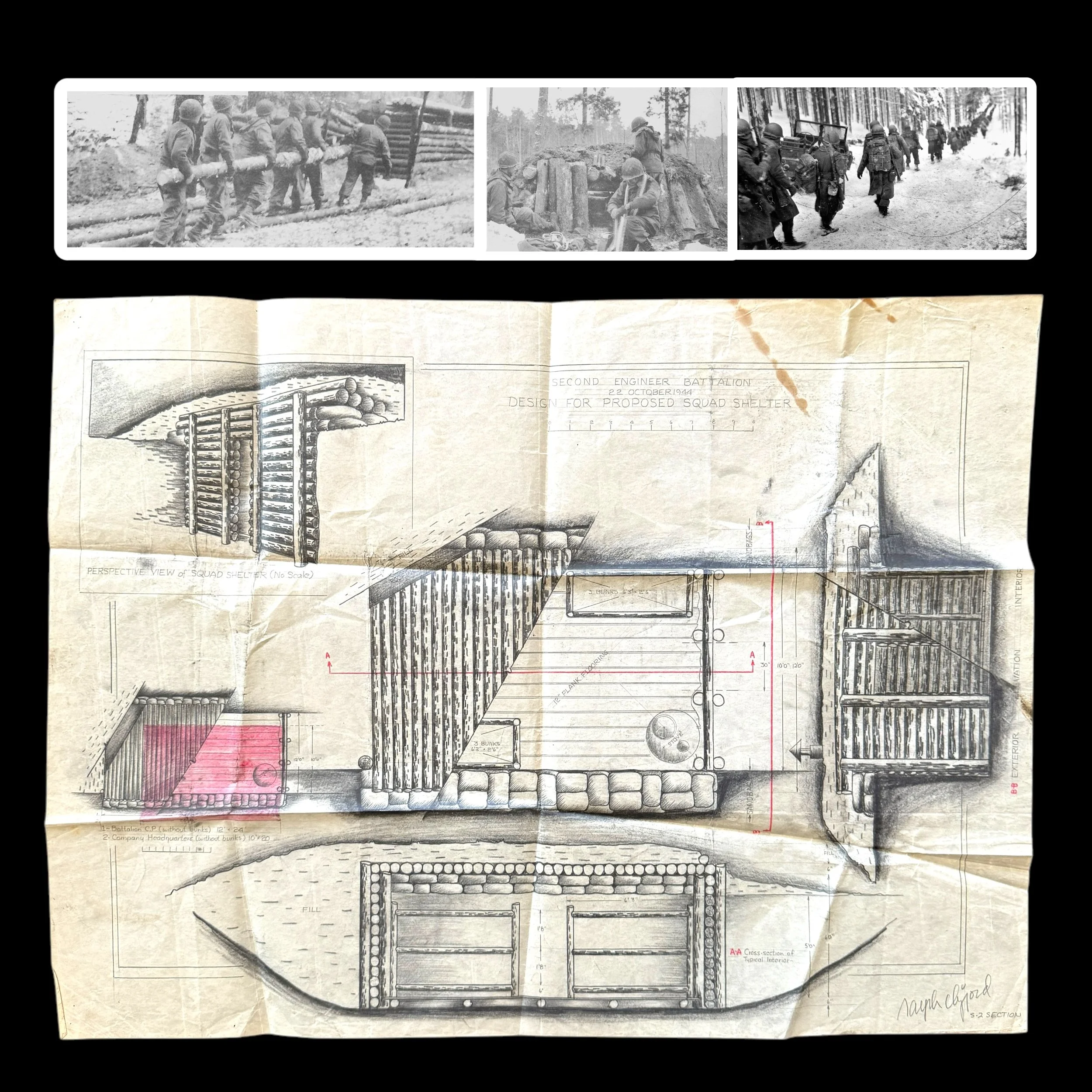

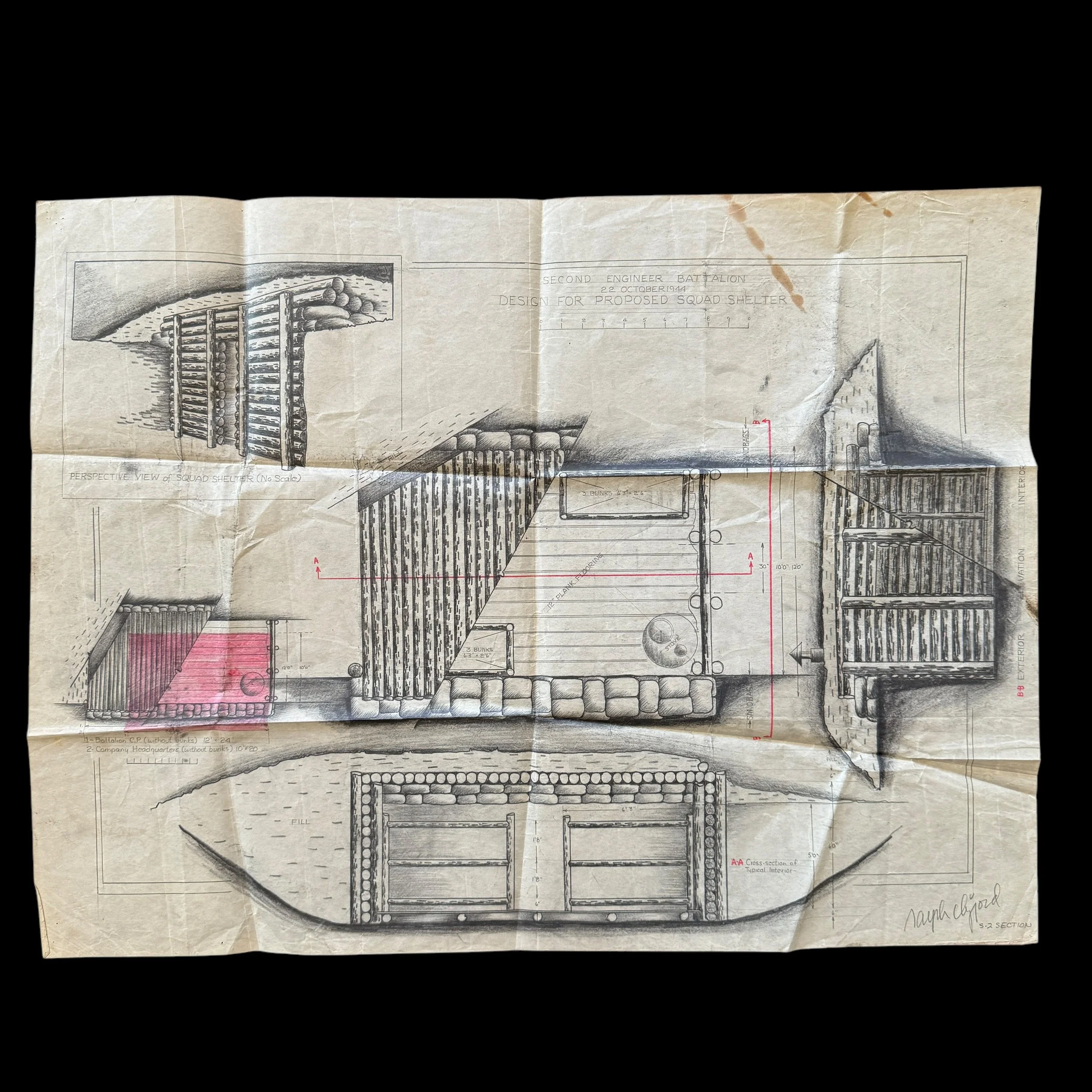
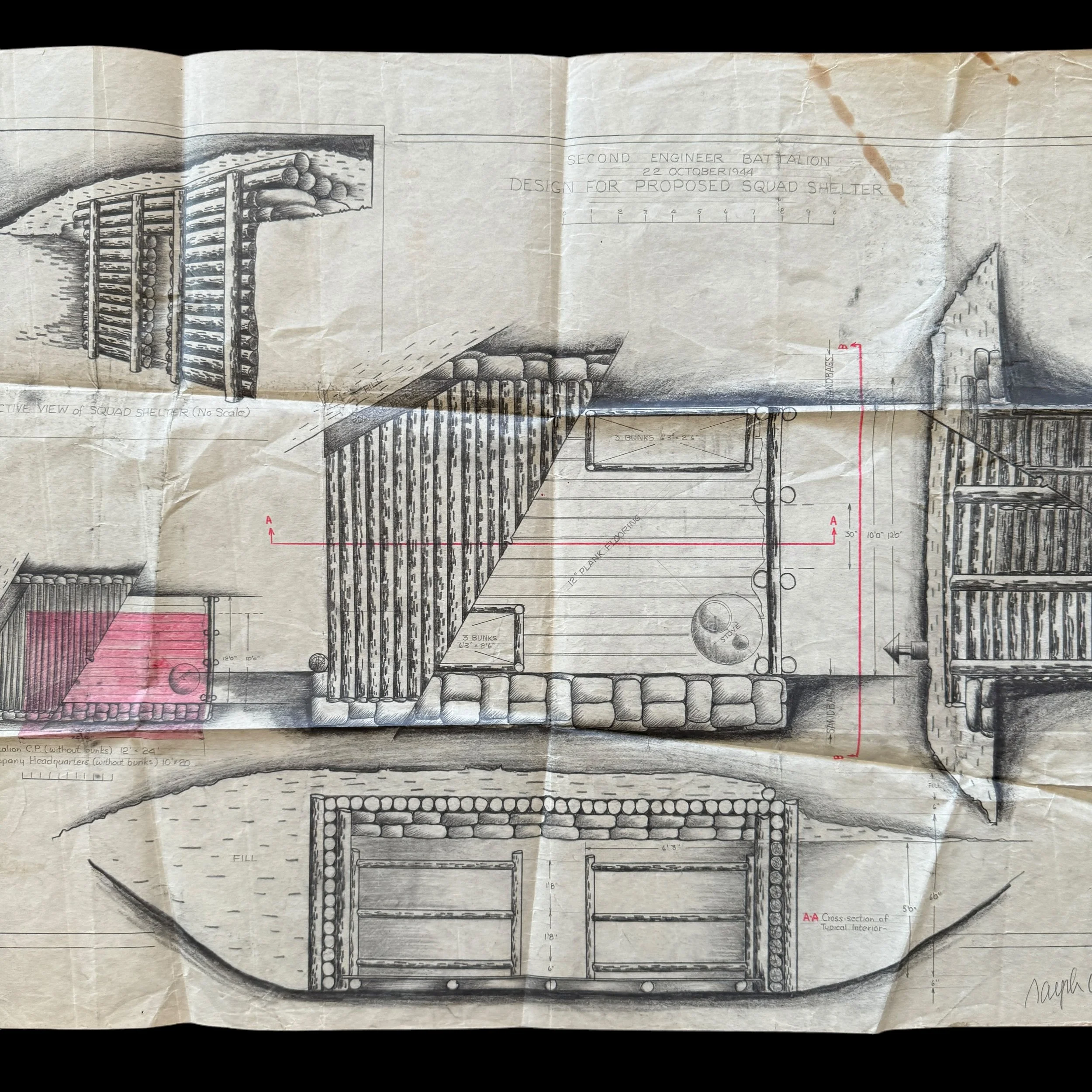
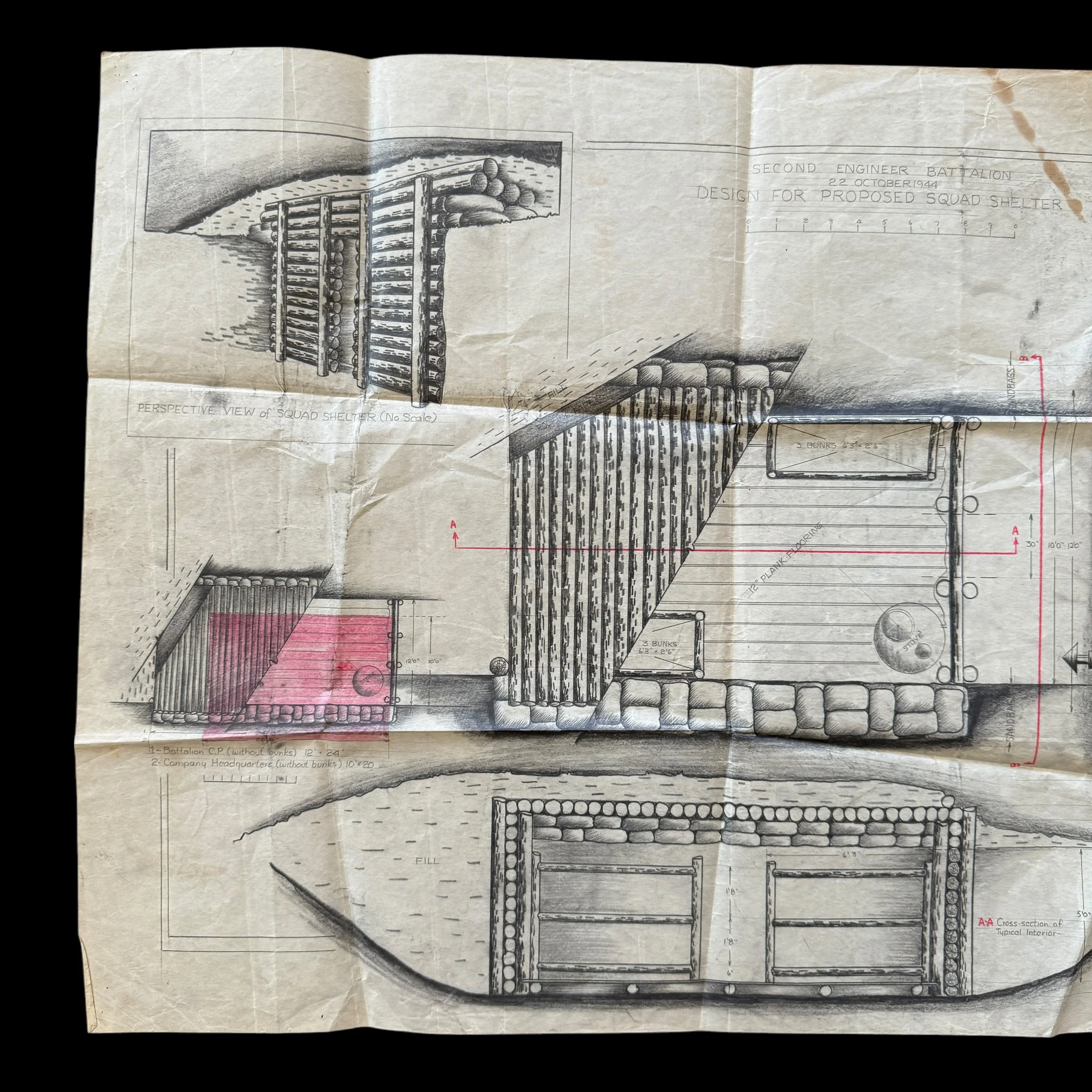
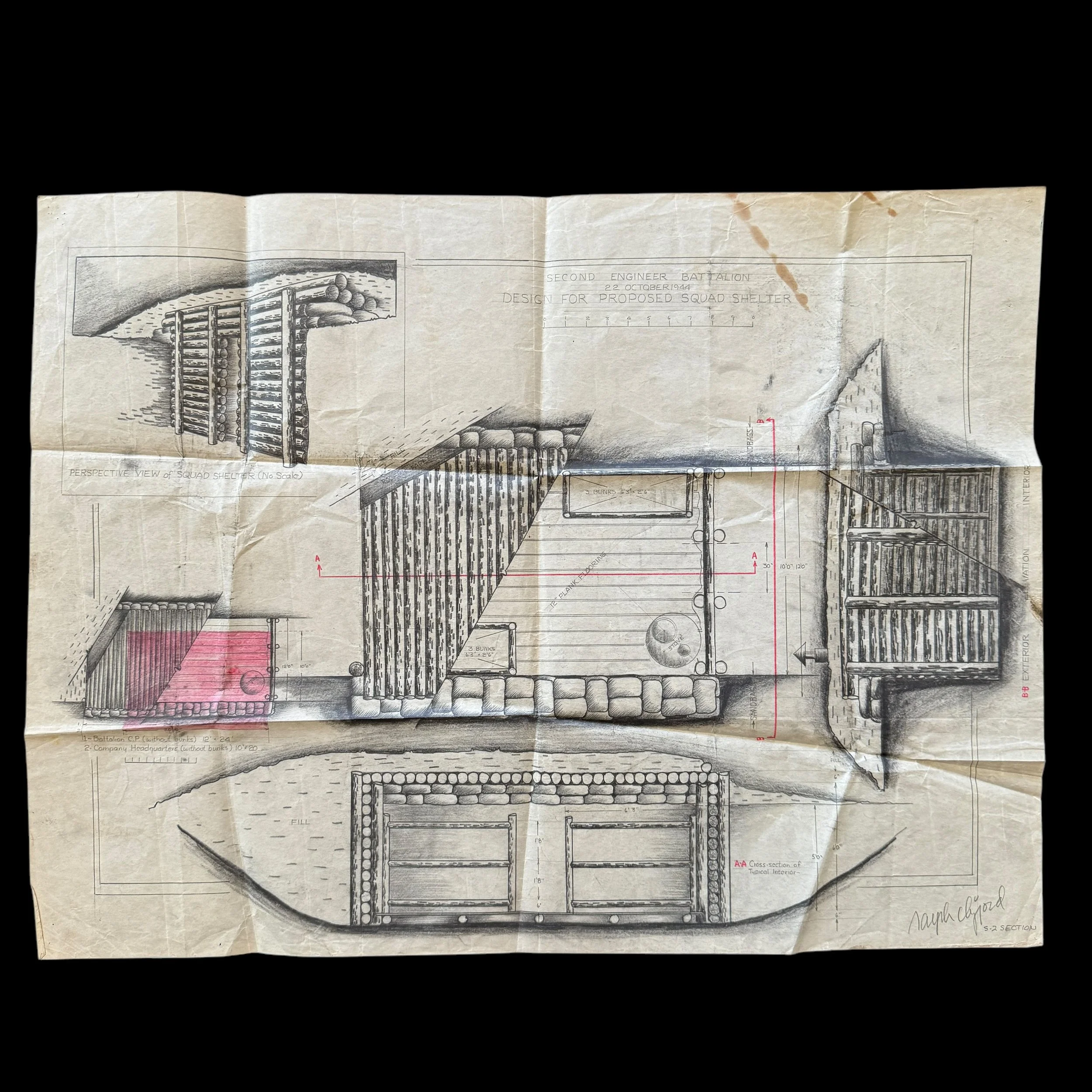



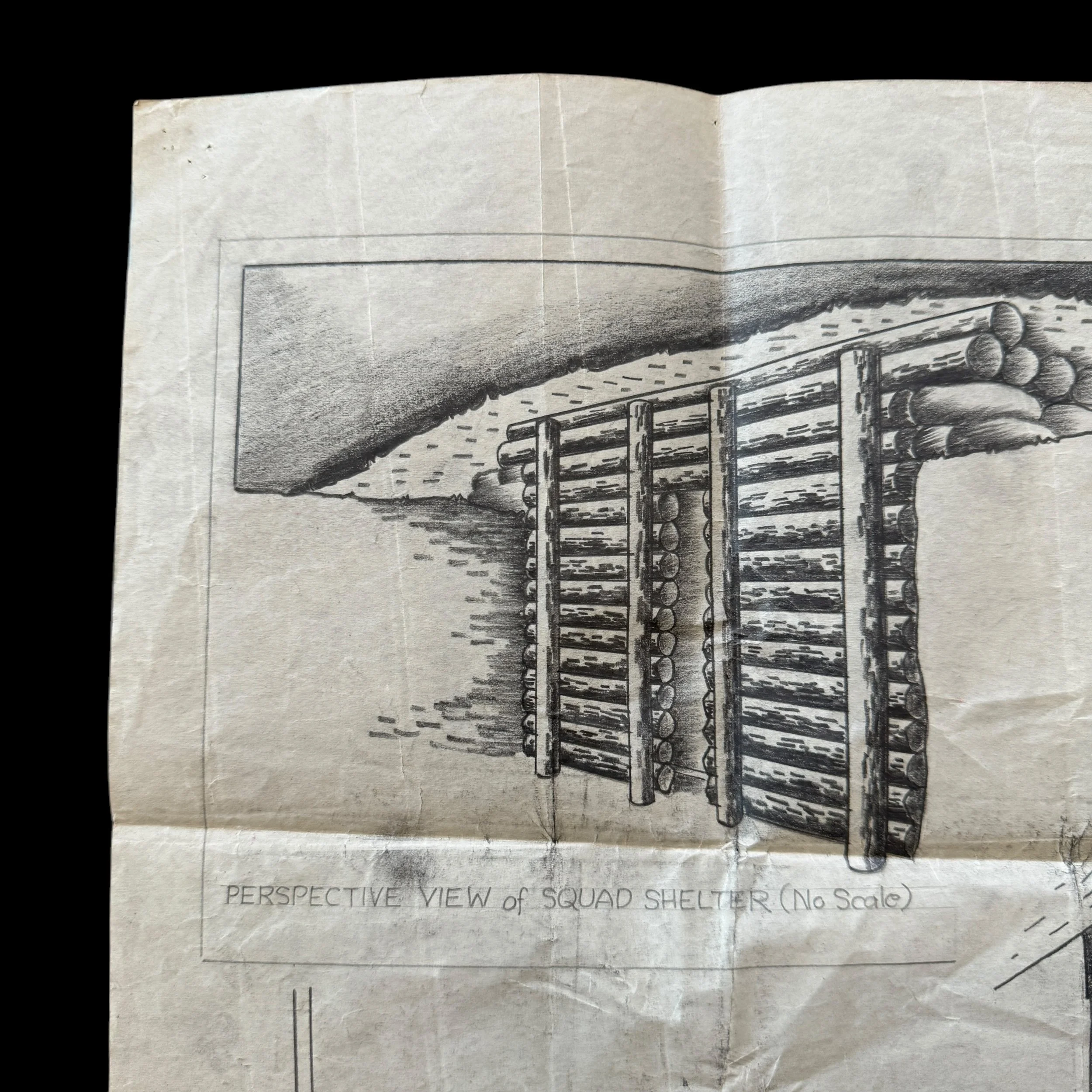
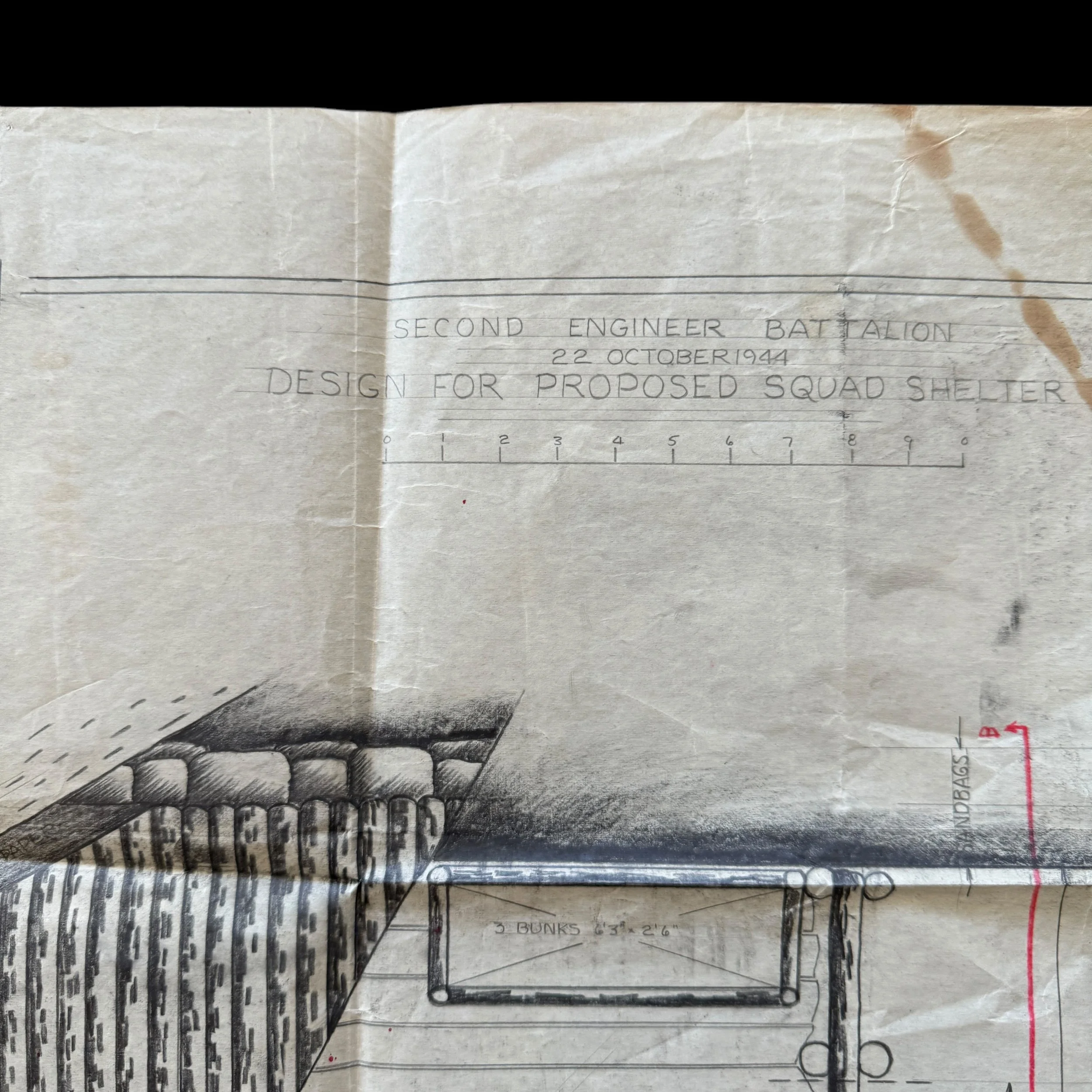

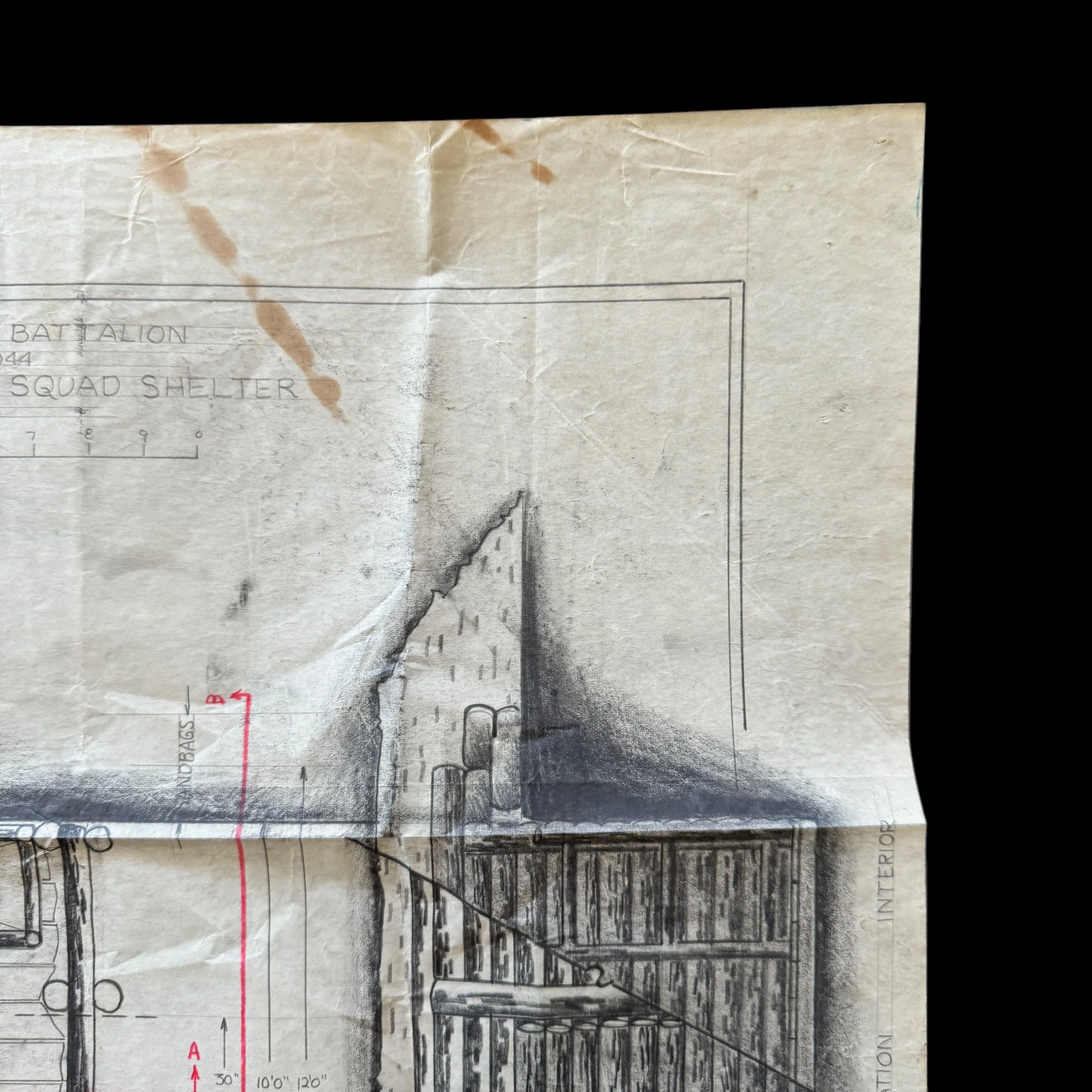
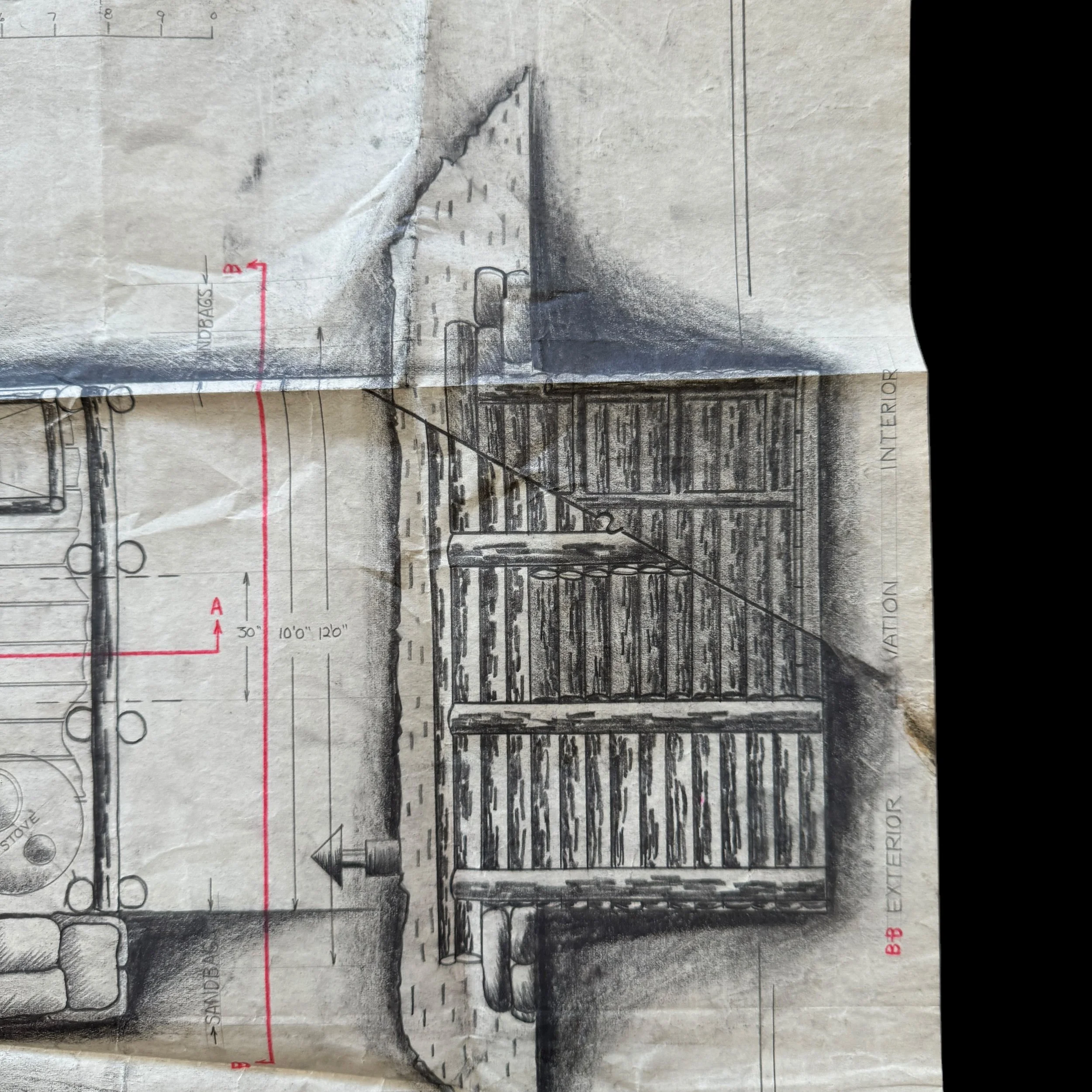
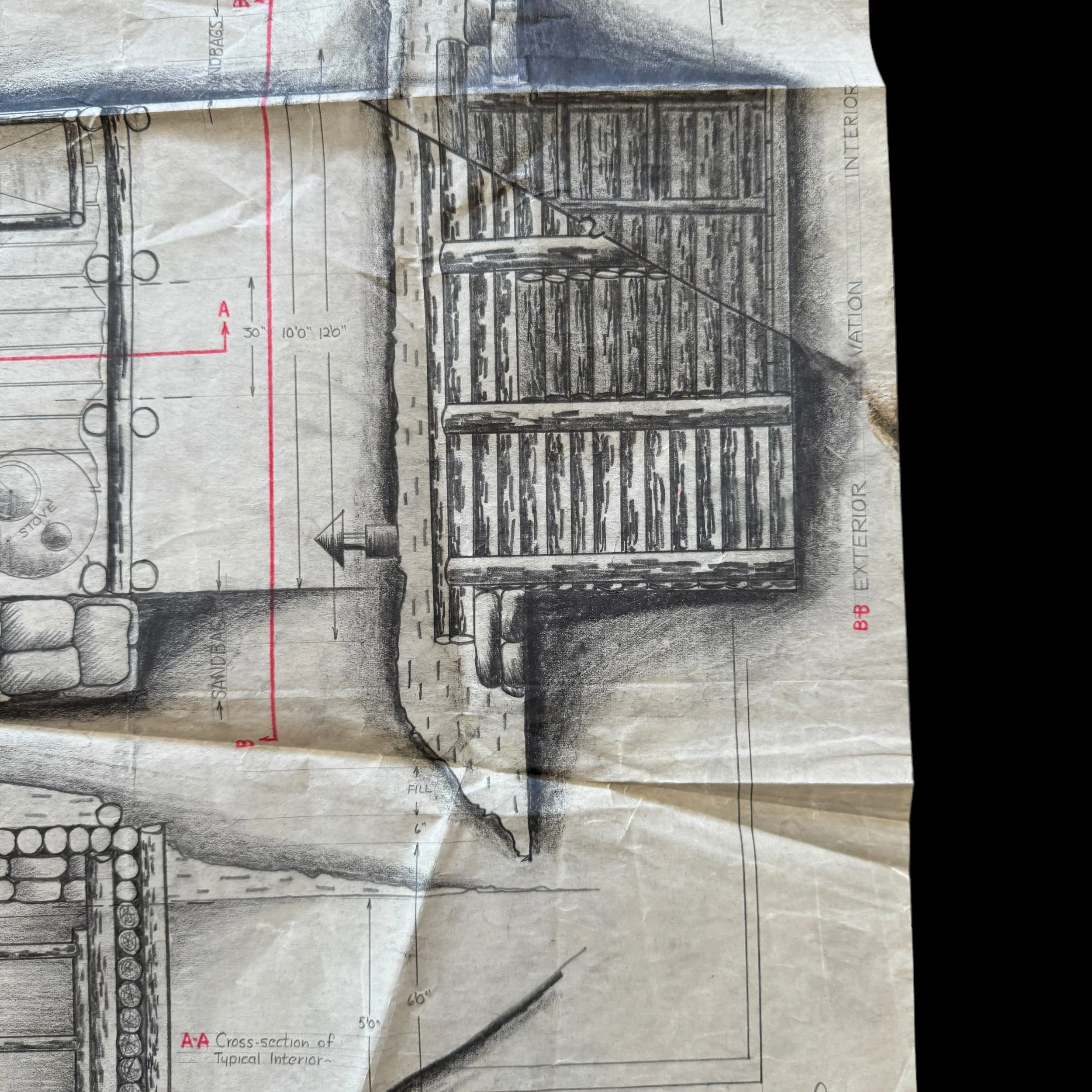
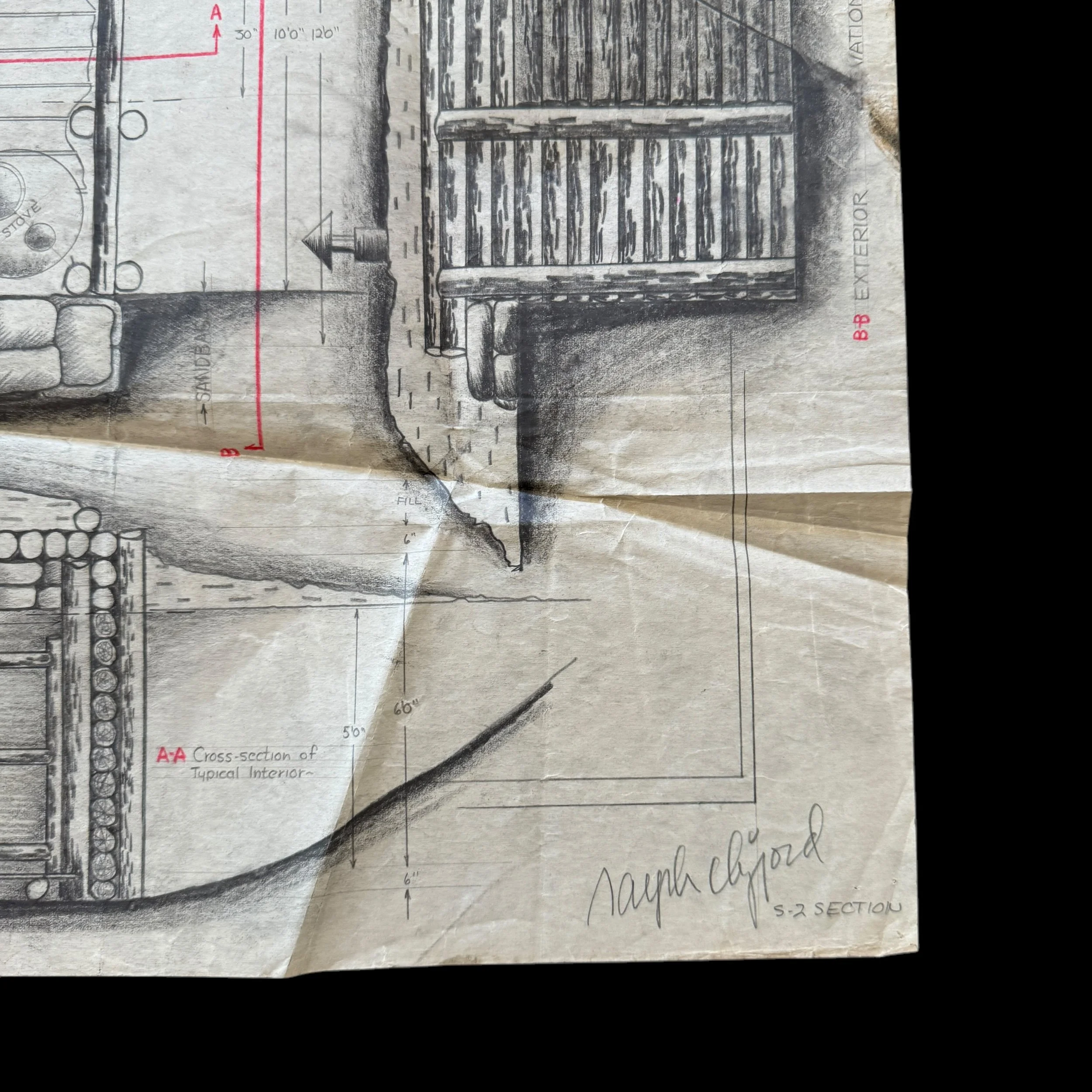
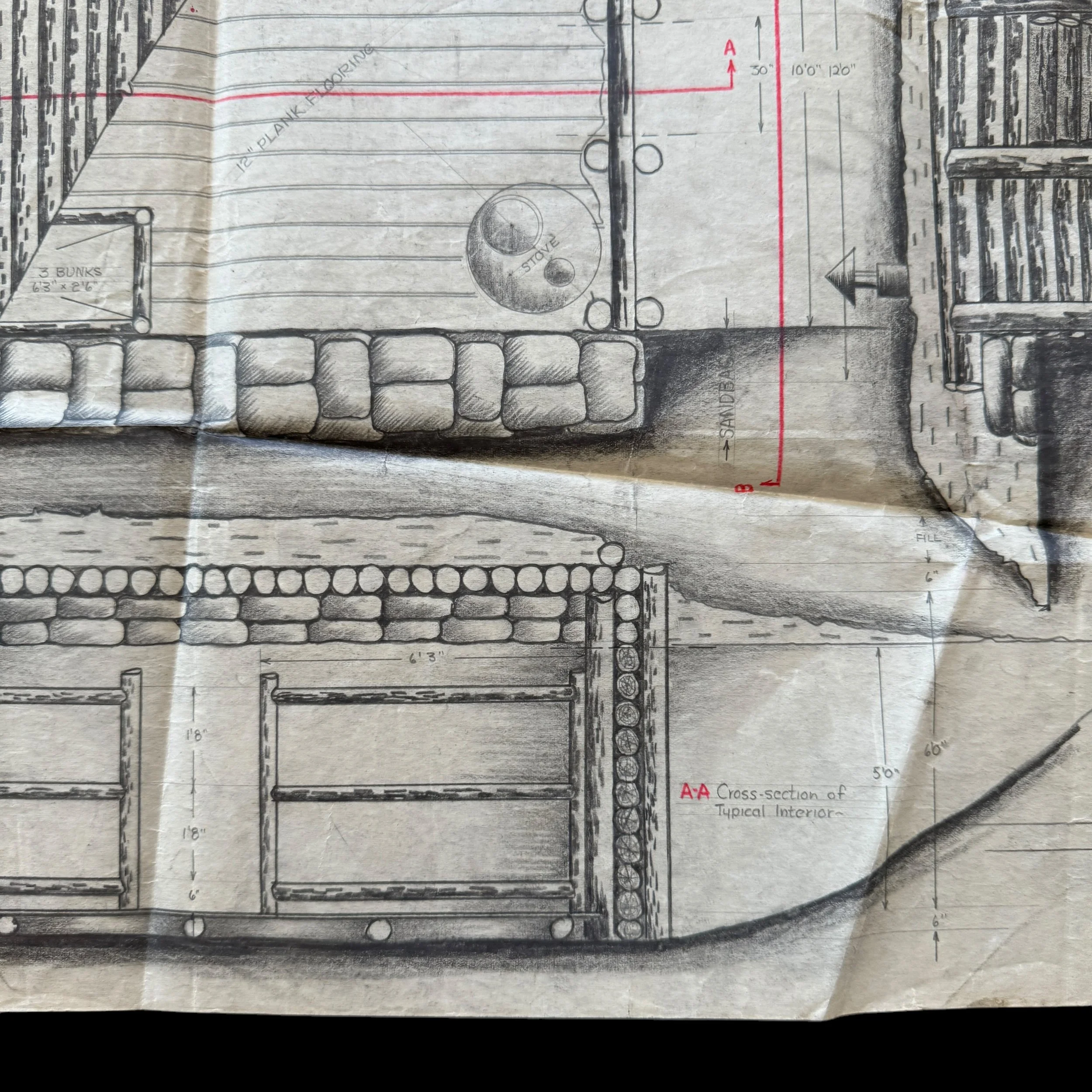
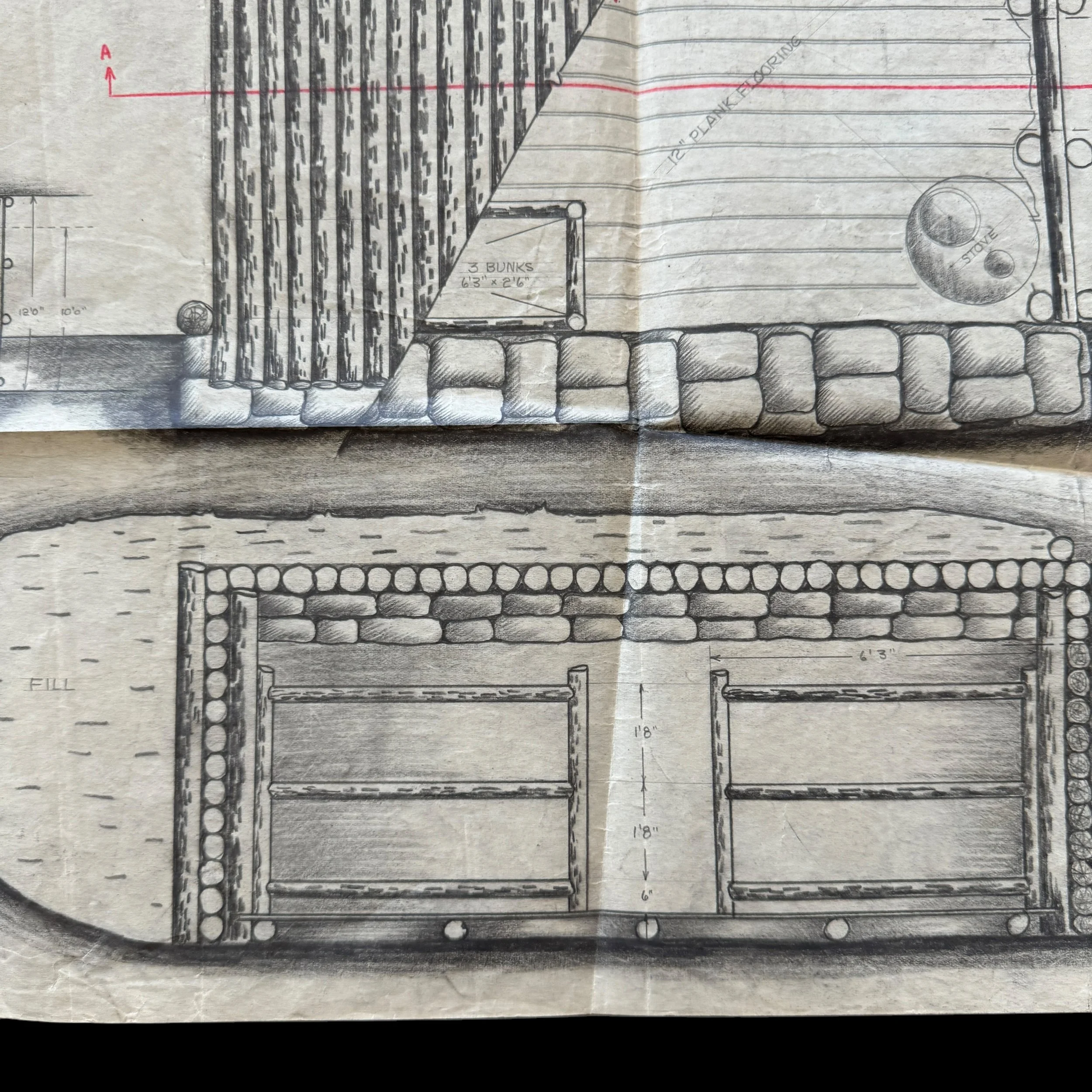

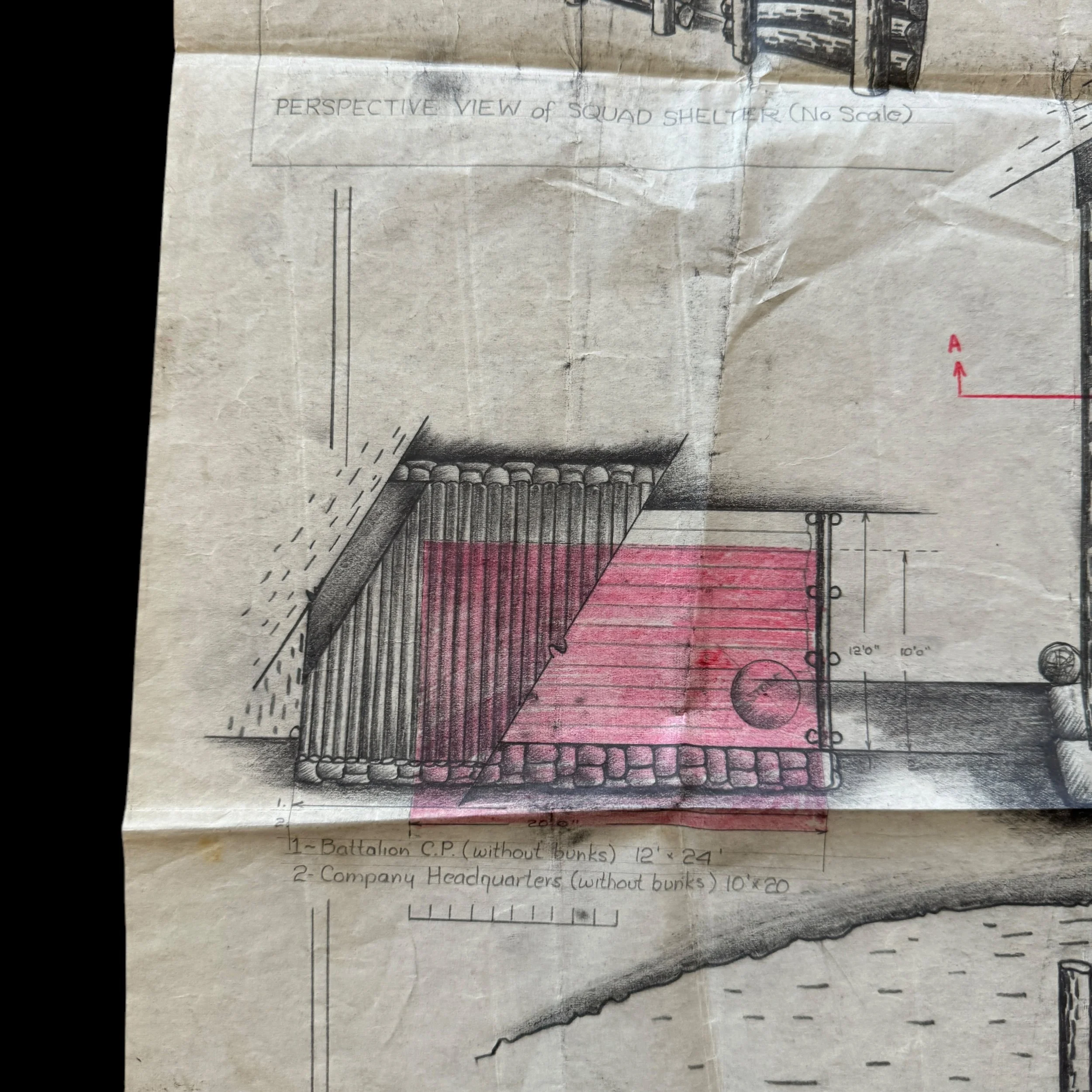
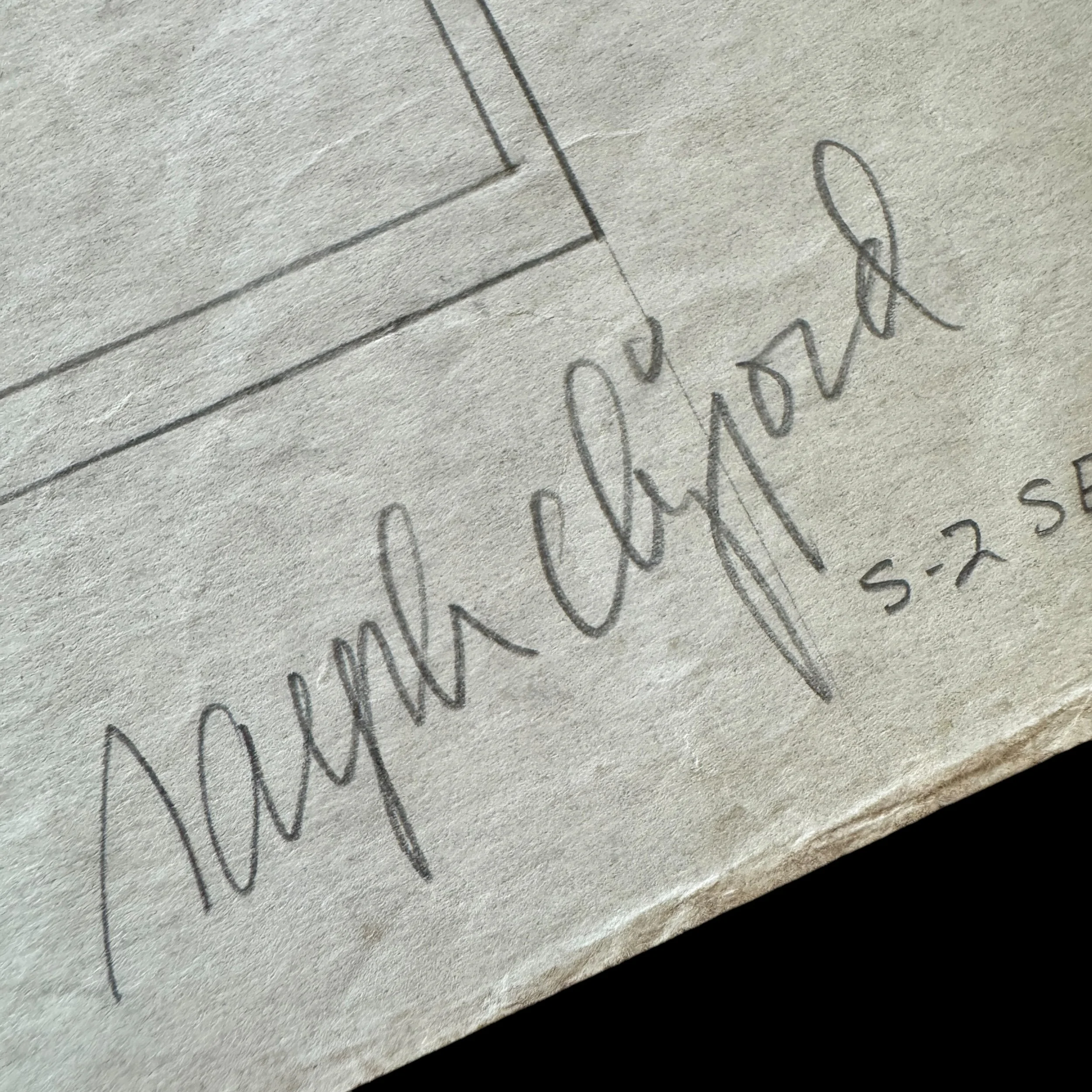
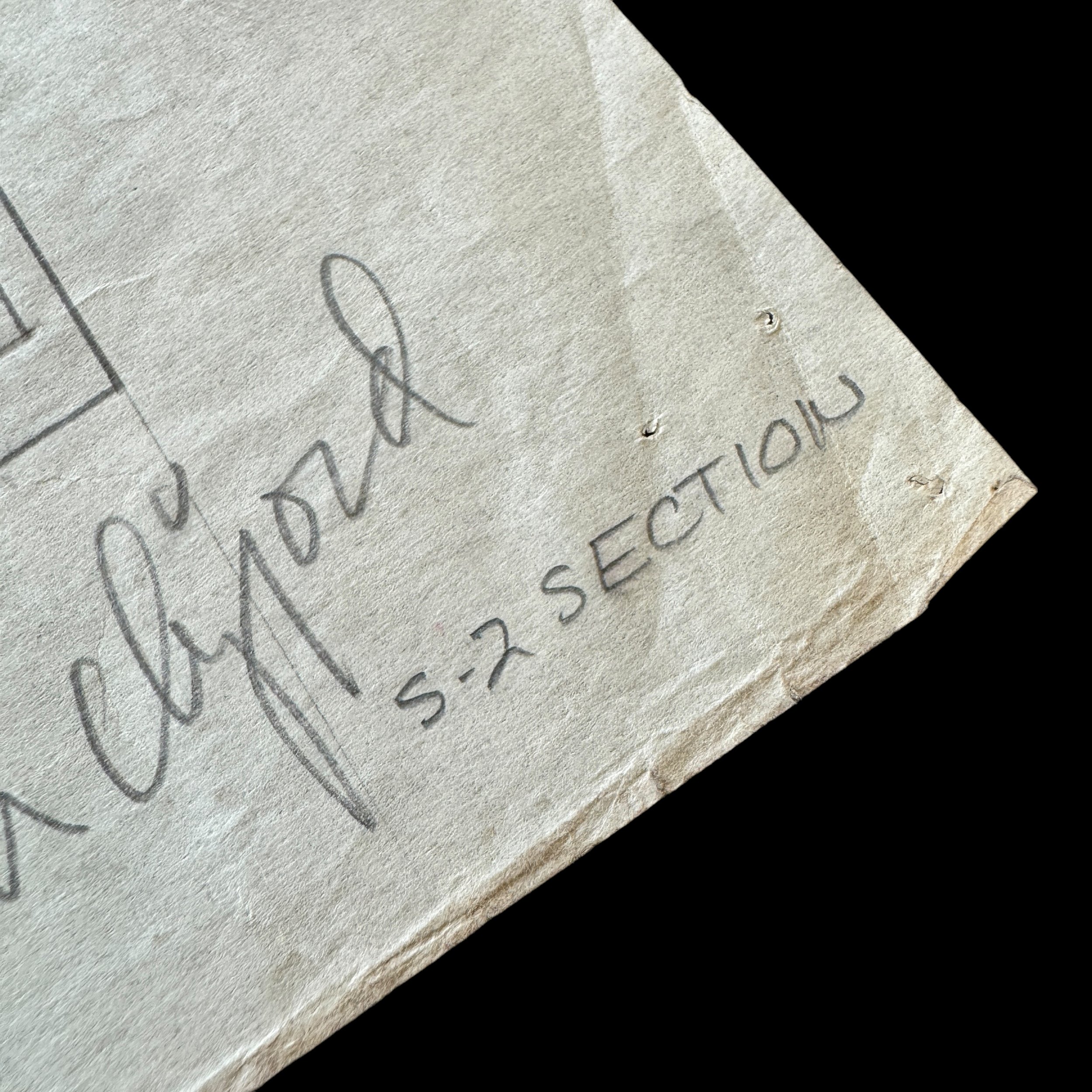

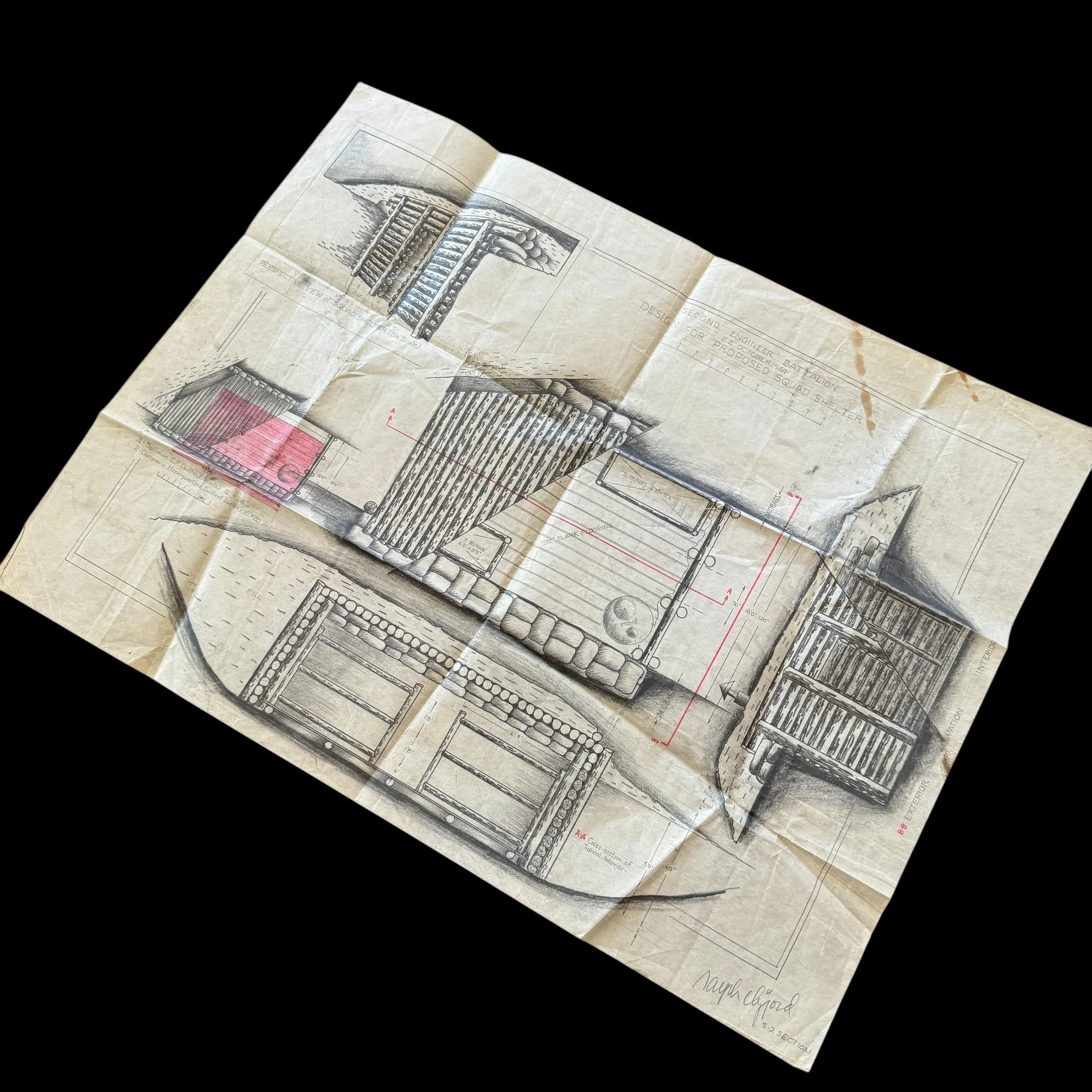
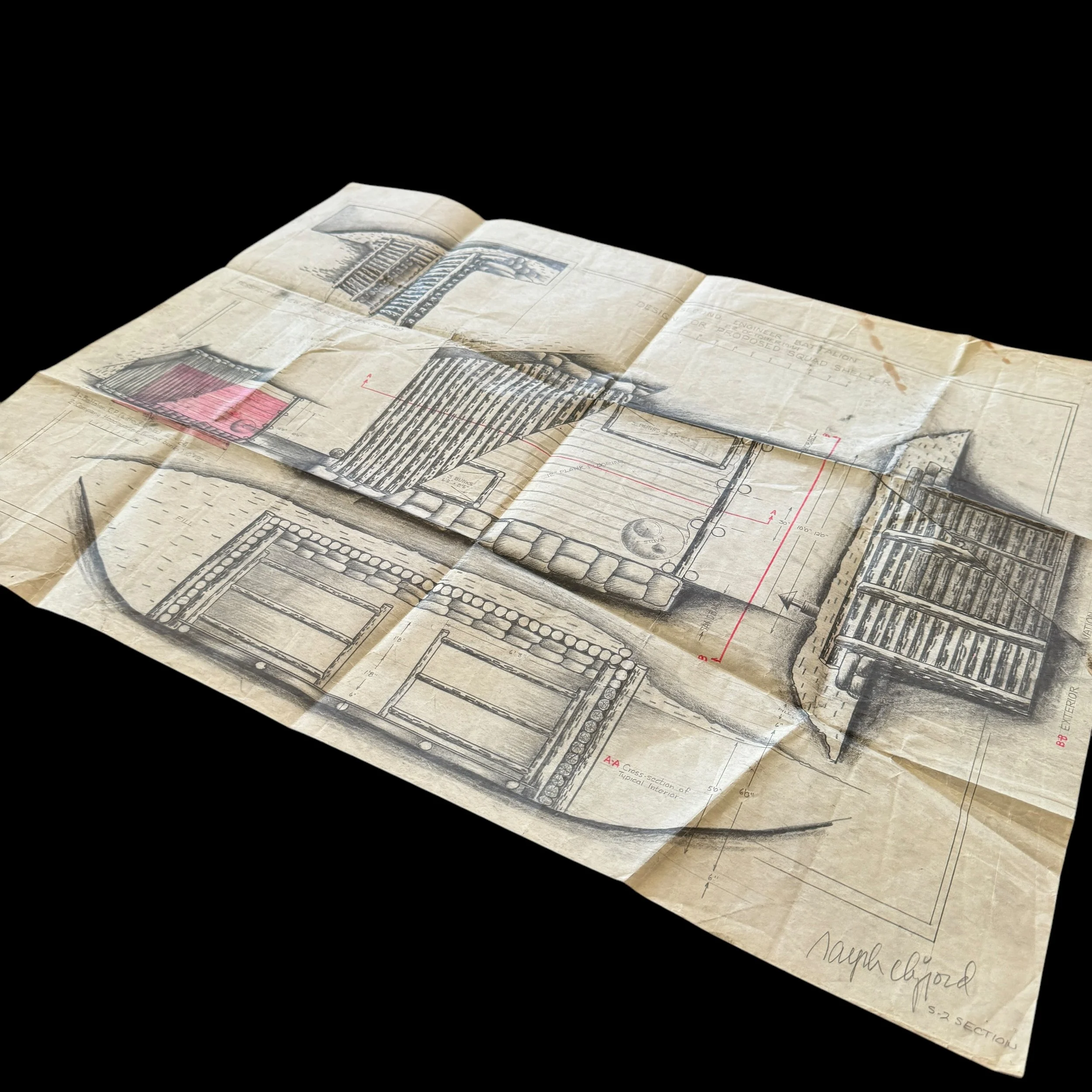



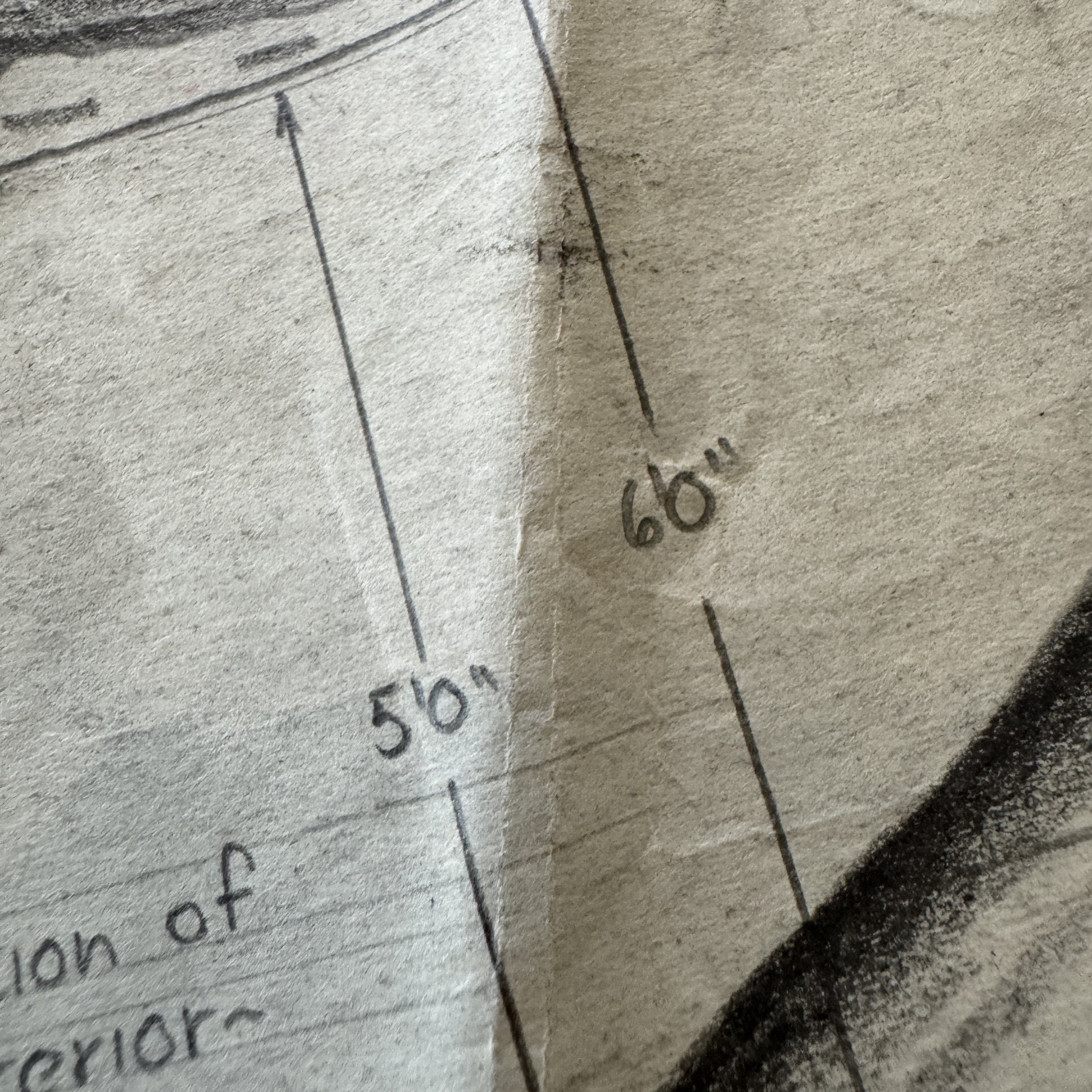
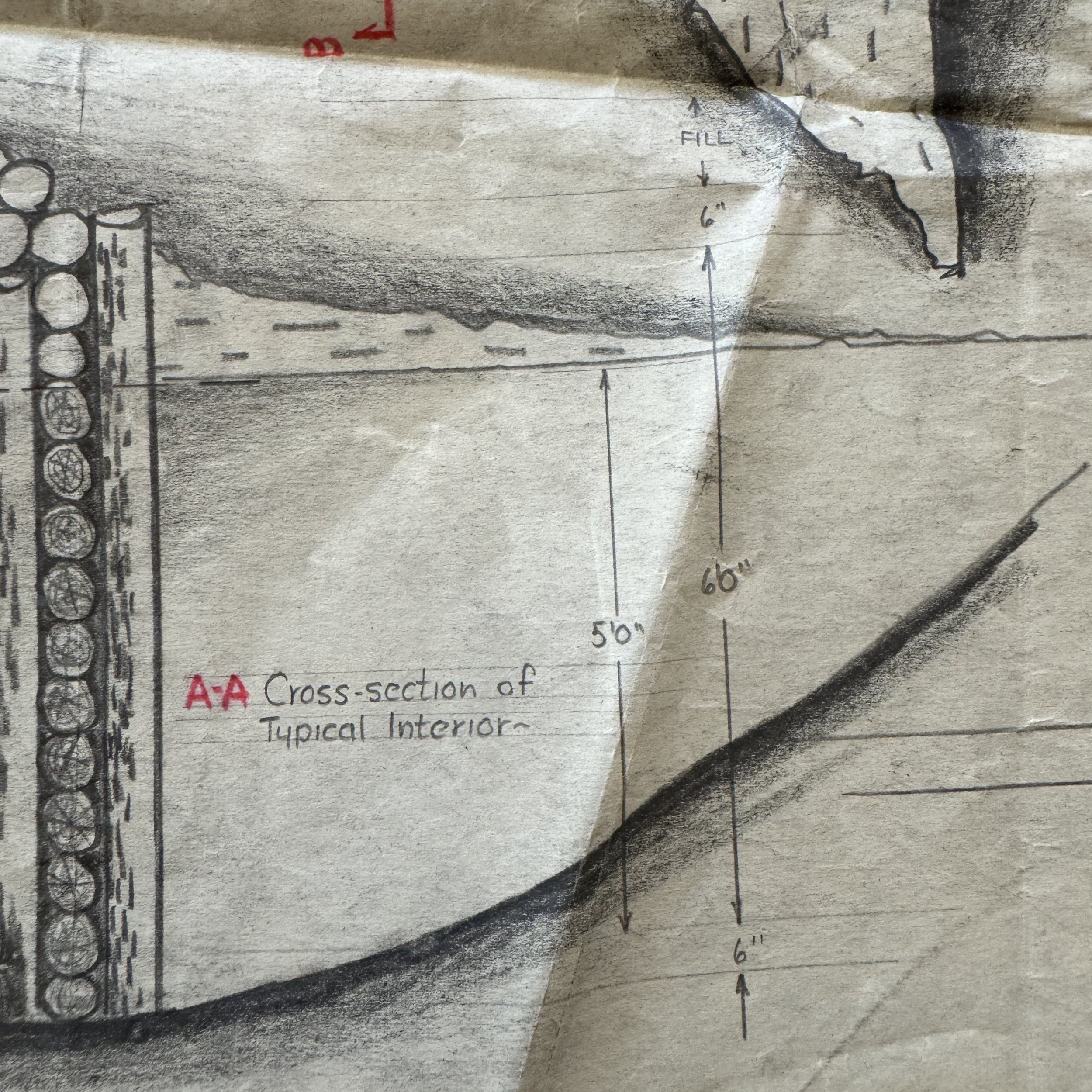




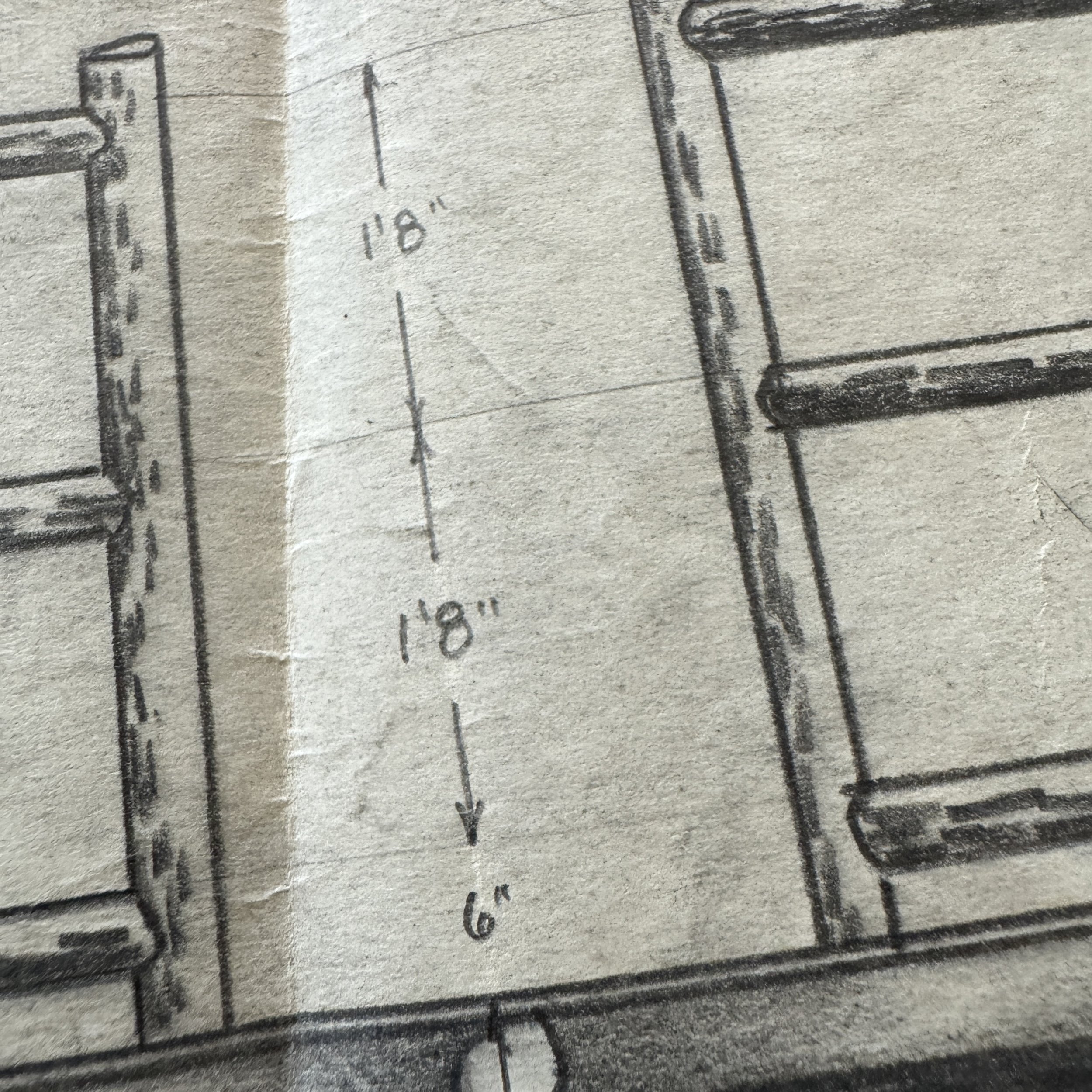
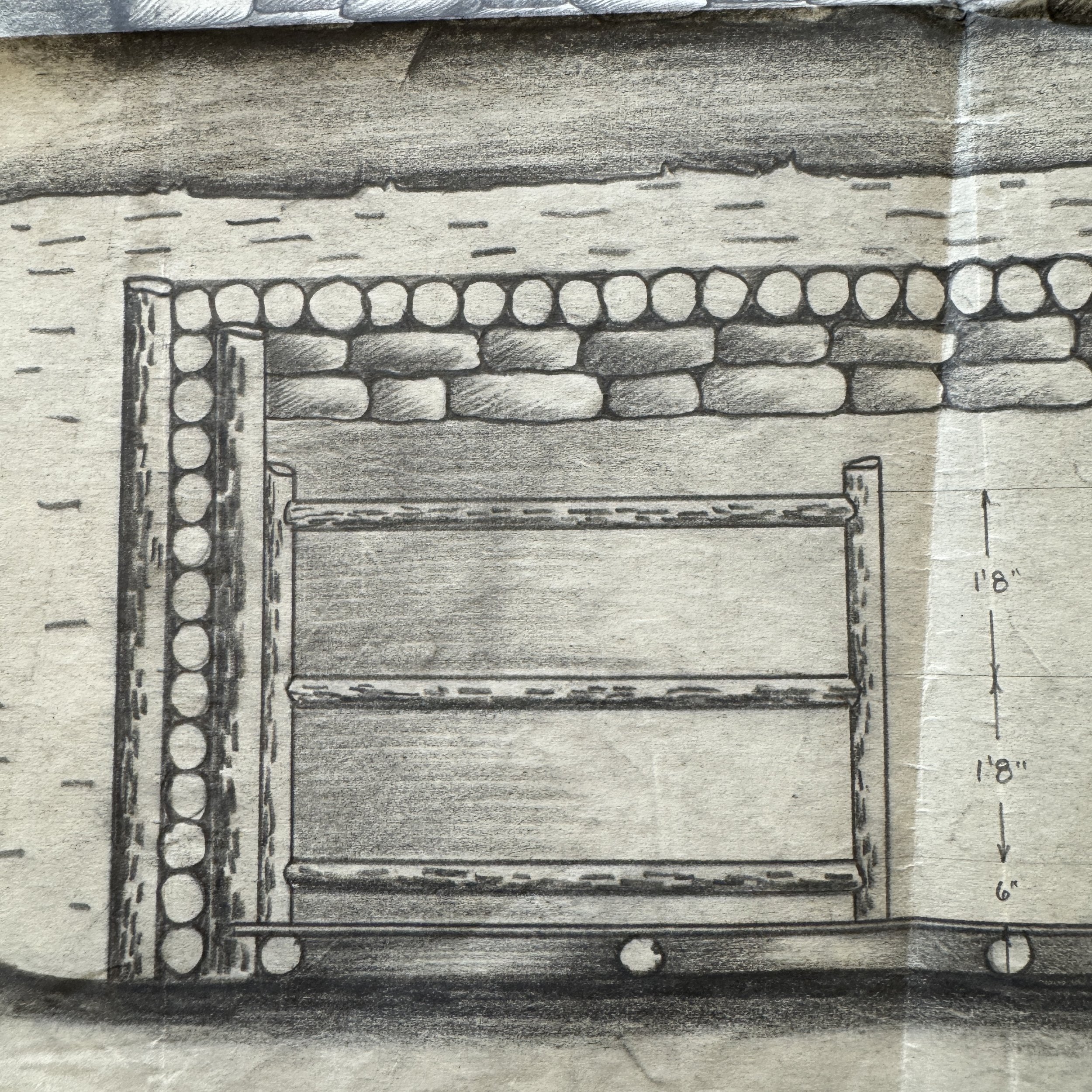









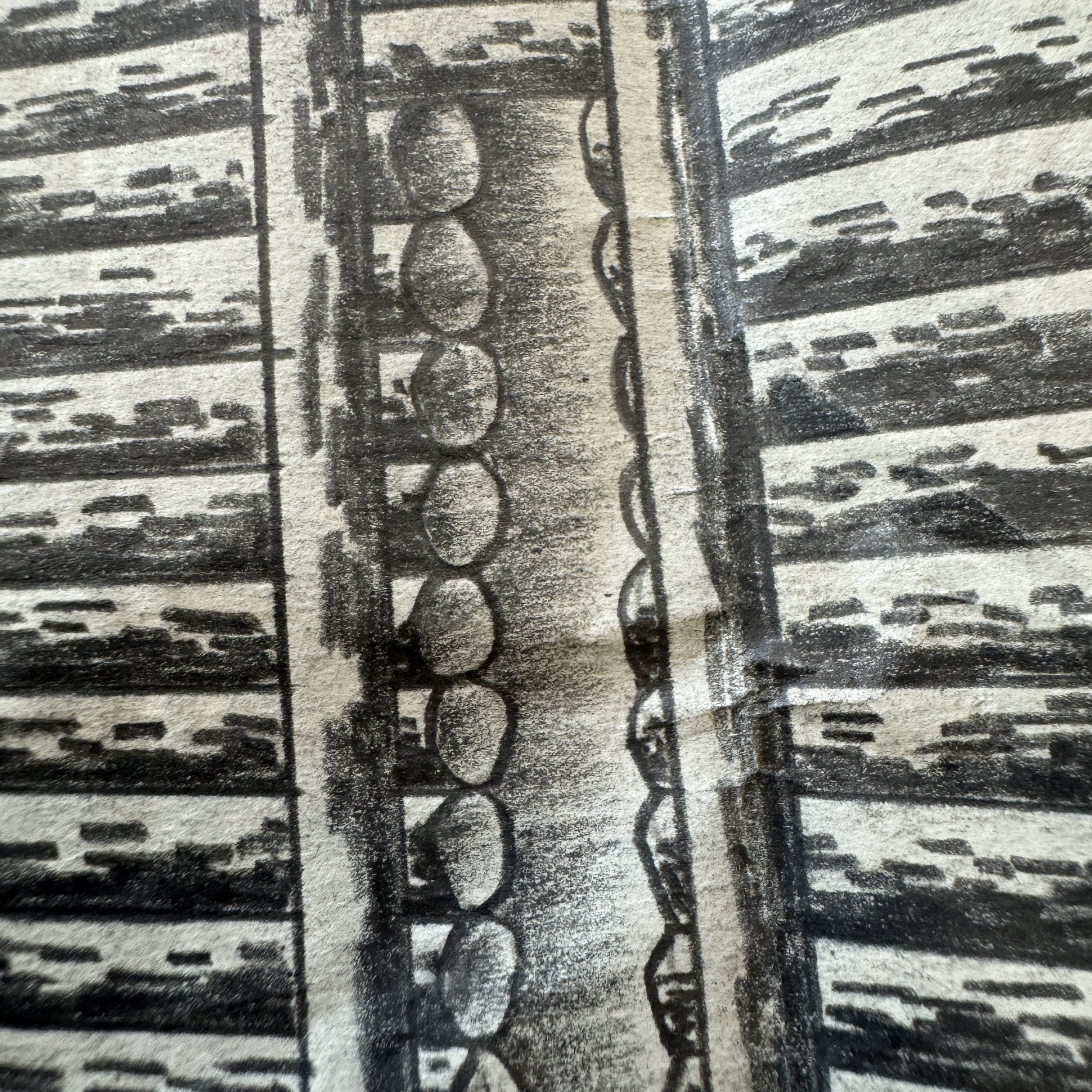

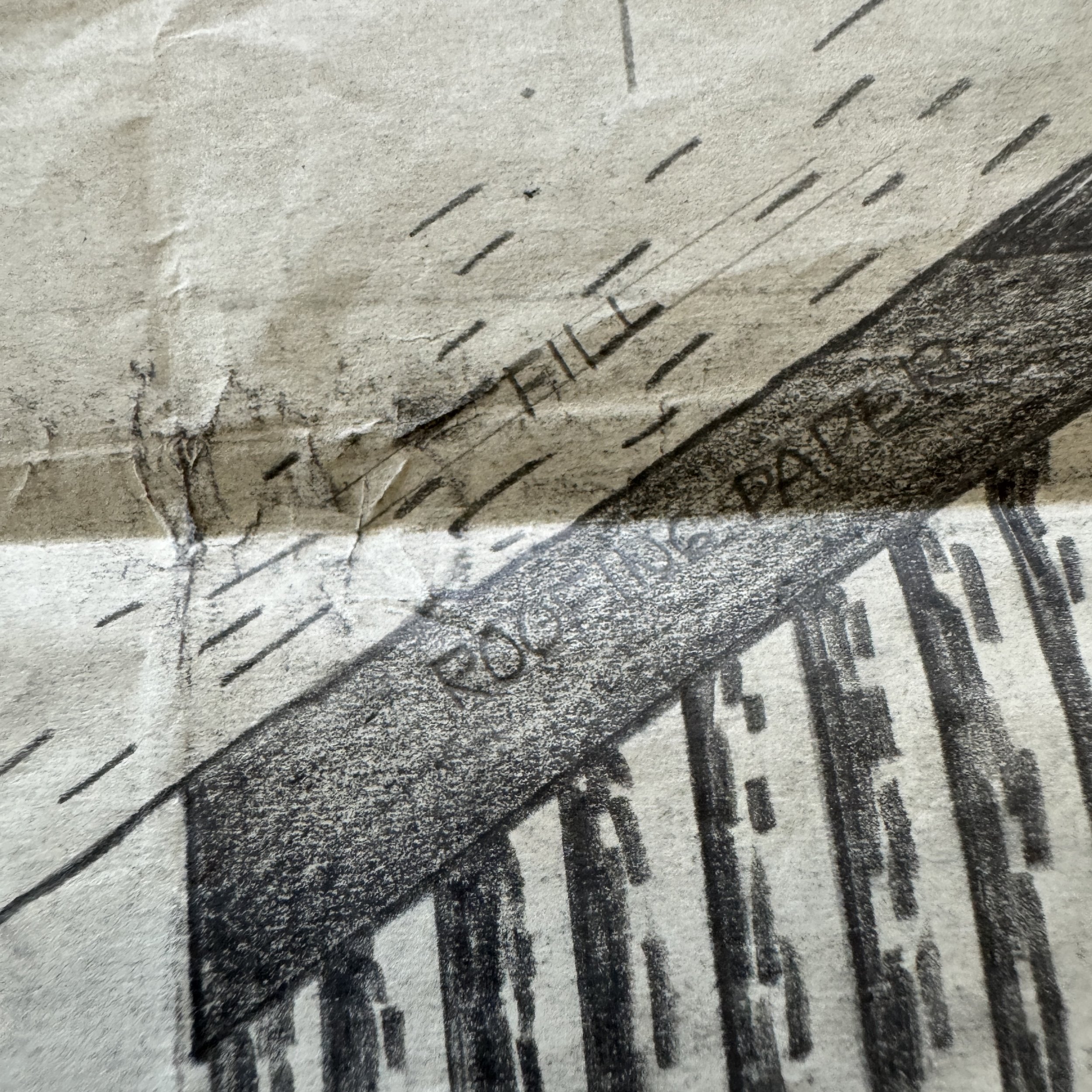



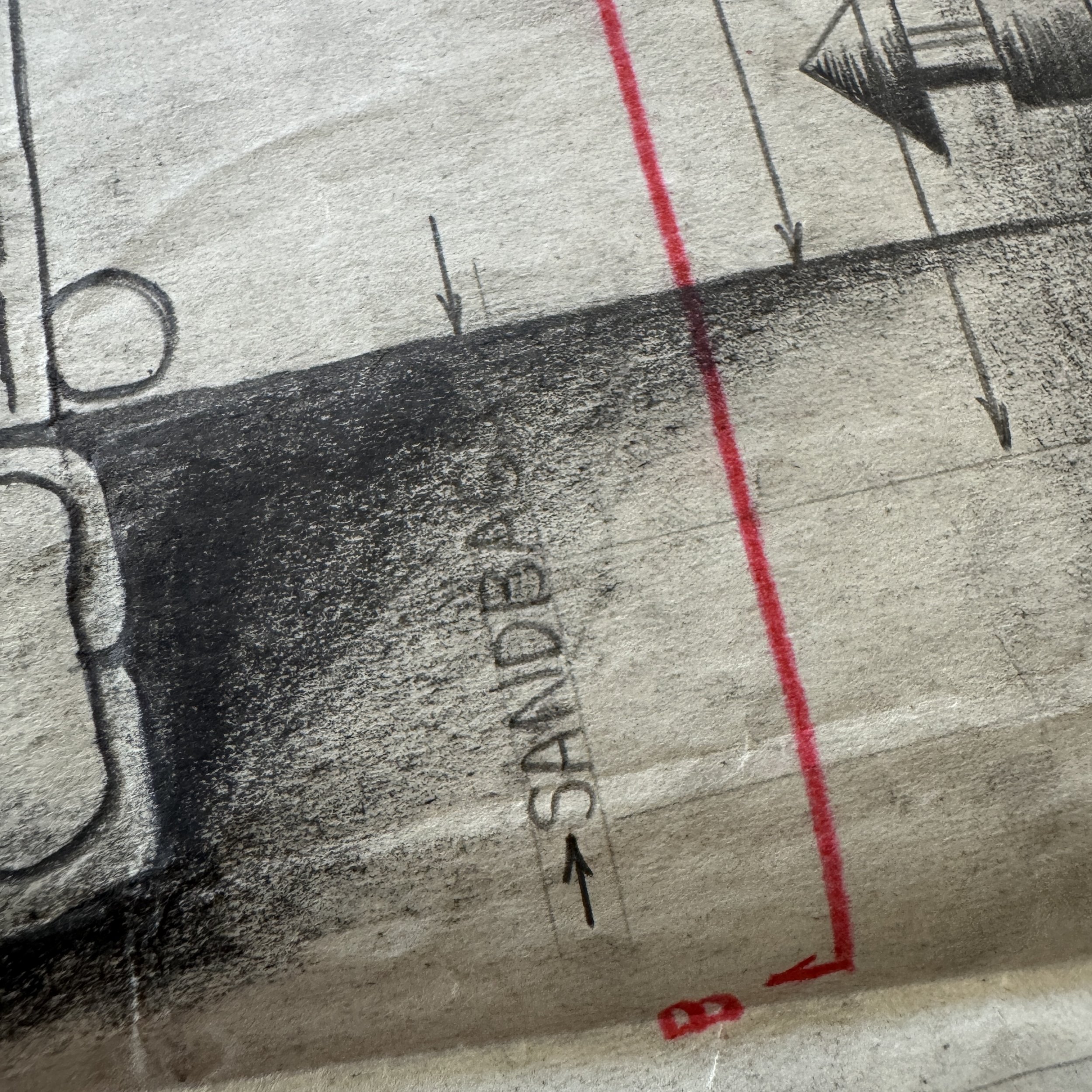






EXTREMELY RARE! WWII 1944 Battle of the Bulge 2nd Engineer Combat Battalion Hand-Drawn "Proposed Squad Shelter" Ardennes Offensive (ONE OF ONE)
Comes with a hand-signed C.O.A.
Size: 18 × 24 inches
2nd Engineer Combat Battalion: Normandy, Northern France, Rhineland, Ardennes-Alsace, Central Europe
Days of combat: 303
This extremely rare and museum-grade artifact from the European Theater of World War II is an original, hand-drawn graphite pencil blueprint dated October 1944, detailing a "Proposed Squad Shelter" designed by the 2nd Engineer Combat Battalion. Created in direct response to the upcoming brutal winter conditions and in preparation for the Battle of the Bulge in December 1944, this engineering plan illustrates the essential role of combat engineers in fortifying American positions during the Ardennes Offensive.
As U.S. forces braced for the impending German counteroffensive, the 2nd Engineer Combat Battalion was tasked with constructing semi-subterranean squad shelters for frontline troops of the 2nd Infantry Division and the 38th Field Artillery Battalion. These shelters were built using the dense Ardennes Forest and locally available materials such as logs, earth, and sandbags to create fortified positions capable of withstanding artillery barrages while also providing critical concealment from enemy observation, particularly near Elsenborn Ridge.
What makes this blueprint even more extraordinary is that it is aone-of-a-kind, hand-drawn document produced by a member of the S-2 section of the 2nd Engineer Combat Battalion. The S-2 section functioned as the battalion’s intelligence unit, responsible for providing timely, accurate, and relevant battlefield intelligence to commanders and staff officers. As the war progressed beyond the Normandy campaign and into France and Belgium, the S-2 section recognized the strategic necessity of providing fortified squad shelters to maintain combat effectiveness in the extreme winter conditions. The shelter designs detailed in this blueprint were essential for ensuring that American infantry units could survive prolonged engagements, particularly during the harsh Ardennes winter. The document itself is remarkably detailed, containing multiple perspectives of the squad shelter along with precise measurements and annotations that showcase the meticulous planning involved in its construction.
This is a once-in-a-lifetime opportunity to acquire an authentic and historically significant artifact that was directly created in support of one of the most infamous battles of World War II. The Battle of the Bulge was a defining moment of the war, and artifacts directly tied to its preparation are exceedingly rare. This original hand-drawn blueprint is the only known example from the 2nd Engineer Combat Battalion available for sale in the public sector, and it is the first of its kind to surface in decades. Because this blueprint was drawn by hand, it remains a singular piece of military history, with even museum collections lacking a comparable example of an original combat-drawn engineering plan of this nature. This document is an irreplaceable testament to the ingenuity, foresight, and adaptability of the U.S. Army’s combat engineers, who played a critical role in securing victory in the European Theater.
The 2nd Engineer Combat Battalion in World War II: Engineering the Path to Victory:
The 2nd Engineer Combat Battalion, part of the 2nd Infantry Division, played a crucial role in the success of Allied operations during World War II. The battalion was responsible for constructing bridges, clearing minefields, fortifying defensive positions, and ensuring mobility for the advancing Allied forces. Throughout the war, the engineers faced harsh combat conditions while performing essential engineering tasks that directly contributed to battlefield success. Their efforts were instrumental in several key campaigns, including the Normandy Invasion, the push through Northern France, the brutal winter battles of the Ardennes-Alsace Campaign, the Rhineland offensive, and the final operations in Central Europe leading to the defeat of Nazi Germany.
Normandy Campaign (June 6 – July 24, 1944)
The 2nd Engineer Combat Battalion landed on Omaha Beach on D-Day, June 6, 1944, as part of the 2nd Infantry Division. Their mission was to support the infantry by clearing beach obstacles, constructing makeshift roads, and securing routes inland. As the battle unfolded, the engineers worked under intense enemy fire, removing deadly German hedgehogs, teller mines, and Belgian gates to allow the advance of infantry and armor. The battalion played a pivotal role in opening up the Vierville Draw, one of the few exits off Omaha Beach, which was essential for the movement of reinforcements and supplies.
After securing the beachhead, the battalion was tasked with road and bridge repair as American forces pushed inland toward Saint-Lô and Caumont-l'Éventé. The terrain of Normandy, characterized by hedgerows, flooded fields, and destroyed infrastructure, presented severe challenges. The engineers frequently worked under fire, clearing German booby traps and mines while ensuring passage for Allied forces.
As the division advanced, the engineers participated in the Battle of Hill 192 on July 11-12, a key engagement against the German 352nd Infantry Division. The hill was a major observation point for the Germans, and its capture allowed the Americans to continue their advance toward Saint-Lô. The 2nd Engineer Combat Battalion provided essential support in road clearing, mine removal, and defensive fortification construction.
Northern France Campaign (July 25 – September 14, 1944)
Following the breakout from Normandy during Operation Cobra on July 25, the 2nd Engineer Combat Battalion moved rapidly across northern France as part of the Allied drive to liberate occupied territories. Their primary responsibilities included constructing pontoon bridges over the Seine River, clearing roads for the 2nd Infantry Division’s advance, and repairing infrastructure destroyed by retreating German forces.
One of the battalion's most critical tasks during this campaign was securing and repairing bridges to maintain the momentum of the Allied push toward Belgium. With German forces using a scorched-earth strategy, bridges were frequently demolished to slow the American advance. The engineers had to quickly construct Bailey bridges under enemy fire, allowing armor and supply convoys to continue moving forward.
Additionally, the battalion played a key role in the liberation of Paris on August 25 by ensuring critical supply routes remained open. They also participated in the battle for Soissons and Laon, where they dismantled roadblocks, secured river crossings, and supported infantry assaults by providing demolition teams to breach enemy defenses.
Rhineland Campaign (September 15, 1944 – March 21, 1945)
The Rhineland Campaign was one of the most challenging operations for the 2nd Engineer Combat Battalion due to the heavily fortified German defensive positions along the Siegfried Line. The engineers were tasked with breaching fortified bunkers, clearing extensive minefields, and constructing supply routes through dense forests and enemy-held territory.
One of the key battles was the assault on the Siegfried Line from September 1944 to February 1945 near Aachen, Germany. The engineers had to destroy massive dragon’s teeth tank traps, barbed wire defenses, and anti-personnel mines, all while being under direct artillery and small arms fire. Using specialized demolition charges and Bangalore torpedoes, they managed to clear several pathways for infantry and tanks to penetrate the German defensive network.
The battalion also participated in Operation Grenade on February 23, 1945, where they built floating bridges across the Roer River under enemy fire. The success of these river crossings enabled American forces to advance deeper into Germany and set the stage for the Rhine River crossings.
Ardennes-Alsace Campaign (December 16, 1944 – January 25, 1945)
The Battle of the Bulge, fought between December 16, 1944, and January 25, 1945, was the largest and bloodiest battle fought by U.S. forces during World War II. The 2nd Engineer Combat Battalion played a vital role in defensive fortifications, roadblock construction, and bridge demolition to slow down the advancing German forces.
During the German offensive, the engineers worked feverishly to destroy key bridges to prevent enemy armor from advancing into Allied-held positions. Near Elsenborn Ridge, where the 2nd Infantry Division made its historic stand, the engineers constructed squad shelters to provide protection from both the brutal winter conditions and enemy bombardments.
As the battle turned in favor of the Allies, the engineers quickly transitioned to bridge reconstruction and mine clearance, ensuring that American forces could go on the offensive and retake lost territory.
Central Europe Campaign (March 22 – May 11, 1945)
As the Allies moved into the heart of Germany, the 2nd Engineer Combat Battalion supported the division in its crossing of the Rhine River during Operation Plunder on March 23, 1945. The battalion constructed pontoon bridges and assault crossings under heavy German fire, allowing the 2nd Infantry Division to push further into Nazi territory.
Following the Rhine crossing, the engineers continued their rapid advance, clearing obstacles and repairing roads as the division moved toward Leipzig and Czechoslovakia. By April 1945, the battalion had reached the Elbe River, where they secured crossings and prepared defensive positions in anticipation of Soviet forces advancing from the east.
By May 8, 1945, Victory in Europe Day, the 2nd Engineer Combat Battalion had played an essential role in enabling the Allied advance across Western Europe, ensuring mobility, fortification, and logistical support throughout the campaign.
The 2nd Engineer Combat Battalion was an indispensable force in the success of the 2nd Infantry Division throughout World War II. From the bloody beaches of Normandy to the bitter cold of the Ardennes, from the treacherous defenses of the Siegfried Line to the final push into Germany, the engineers demonstrated exceptional skill, resilience, and bravery. Their ability to construct, demolish, and fortify under extreme conditions not only allowed the infantry to advance but also contributed to the overall success of the Allied victory in Europe. The legacy of the 2nd Engineer Combat Battalion remains one of valor, ingenuity, and dedication, making them one of the most critical engineering units of World War II.